A Rapid Label-Free Fluorescent Aptasensor PicoGreen-Based Strategy for Aflatoxin B1 Detection in Traditional Chinese Medicines
Abstract
:1. Introduction
2. Results and Discussion
2.1. Principle Underlying Label-Free Aptasensor Strategy
2.2. Screening of AFB1-Specific Aptamers Using Aptasensor Strategy
2.3. Specificity of the Label-Free Fluorescent Aptasensor for AFB1
2.4. Optimization of Detection Conditions
2.4.1. PG Amount
2.4.2. PG and dsDNA Reaction Time
2.5. Method Validation
2.6. Application to Real Samples
3. Conclusions
4. Materials and Methods
4.1. Reagents and Chemicals
4.2. Sample Preparation
4.3. Fluorescent Detection
Supplementary Materials
Acknowledgments
Author Contributions
Conflicts of Interest
Appendix A
References
- Cancer, I.A.F.O. Some Naturally Occurring Substances: Food Items and Constituents, Heterocyclic Aromatic Amines and Mycotoxins; World Health Organization: Geneva, Switzerland, 1993. [Google Scholar]
- Heather, S.; Eduardo, A.-B.; EMarianne, B.; Ramesh, V.B.; Robert, B.; Brune, M.N.; DeCock, K.; Dilley, A.; Groopman, J.; Hell, K. Workgroup report: Public health strategies for reducing aflatoxin exposure in developing countries. Environ. Health Perspect. 2006, 114, 1898–1903. [Google Scholar]
- Kensler, T.W.; Roebuck, B.D.; Wogan, G.N.; Groopman, J.D. Aflatoxin: A 50-Year Odyssey of Mechanistic and Translational Toxicology. Toxicol. Sci. 2011, 120 (Suppl. 1), S28–S48. [Google Scholar] [CrossRef] [PubMed]
- Bbosa, G.S.; Kitya, D.; Odda, J.; Ogwalokeng, J. Aflatoxins metabolism, effects on epigenetic mechanisms and their role in carcinogenesis. Health 2013, 5, 14–34. [Google Scholar] [CrossRef]
- Abdel-Aziem, S.H. Dietary supplementation with whey protein and ginseng extract counteracts oxidative stress and DNA damage in rats fed an aflatoxin-contaminated diet. Mutat. Res. 2011, 723, 65–71. [Google Scholar] [CrossRef] [PubMed]
- Mary, V.S.; Theumer, M.G.; Arias, S.L.; Rubinstein, H.R. Reactive oxygen species sources and biomolecular oxidative damage induced by aflatoxin B1 and fumonisin B1 in rat spleen mononuclear cells. Toxicology 2012, 302, 299–307. [Google Scholar] [CrossRef] [PubMed]
- Abbès, S.; Salah-Abbès, J.B.; Sharafi, H.; Jebali, R.; Noghabi, K.A.; Oueslati, R. Ability of Lactobacillus rhamnosus GAF01 to remove AFM1in vitro and to counteract AFM1 immunotoxicity in vivo. J. Immunotoxicol. 2013, 10, 279–286. [Google Scholar] [CrossRef] [PubMed]
- Fallah, A.A. Aflatoxin M1 contamination in dairy products marketed in Iran during winter and summer. Food Control 2010, 21, 1478–1481. [Google Scholar] [CrossRef]
- Ji, E.L.; Kwak, B.M.; Ahn, J.H.; Jeon, T.H. Occurrence of aflatoxin M 1 in raw milk in South Korea using an immunoaffinity column and liquid chromatography. Food Control 2009, 20, 136–138. [Google Scholar]
- Abia, W.A.; Warth, B.; Sulyok, M.; Krska, R.; Tchana, A.N.; Njobeh, P.B.; Dutton, M.F.; Moundipa, P.F. Determination of multi-mycotoxin occurrence in cereals, nuts and their products in Cameroon by liquid chromatography tandem mass spectrometry (LC-MS/MS). Food Control 2013, 31, 438–453. [Google Scholar] [CrossRef]
- Li, M.; Kong, W.; Li, Y.; Liu, H.; Liu, Q.; Dou, X.; Ouyang, Z.; Yang, M. High-throughput determination of multi-mycotoxins in Chinese yam and related products by ultra fast liquid chromatography coupled with tandem mass spectrometry after one-step extraction. J. Chromatogr. B 2016, 1022, 118–125. [Google Scholar] [CrossRef] [PubMed]
- Guan, D.; Li, P.; Zhang, Q.; Zhang, W.; Zhang, D.; Jiang, J. An ultra-sensitive monoclonal antibody-based competitive enzyme immunoassay for aflatoxin M1 in milk and infant milk products. Food Chem. 2011, 125, 1359–1364. [Google Scholar] [CrossRef]
- Bradburn, N.; Coker, R.D.; Blunden, G. A comparative study of solvent extraction efficiency and the performance of immunoaffinity and solid phase columns on the determination of aflatoxin B 1. Food Chem. 1995, 52, 179–185. [Google Scholar] [CrossRef]
- Romagnoli, B.; Menna, V.; Gruppioni, N.; Bergamini, C. Aflatoxins in spices, aromatic herbs, herb-teas and medicinal plants marketed in Italy. Food Control 2007, 18, 697–701. [Google Scholar] [CrossRef]
- Nonaka, Y.; Saito, K.; Hanioka, N.; Narimatsu, S.; Kataoka, H. Determination of aflatoxins in food samples by automated on-line in-tube solid-phase microextraction coupled with liquid chromatography-mass spectrometry. J. Chromatogr. A 2009, 1216, 4416–4422. [Google Scholar] [CrossRef] [PubMed]
- Zhao, M.; Zhuo, Y.; Chai, Y.; Xiang, Y.; Liao, N.; Gui, G.; Yuan, R. Dual signal amplification strategy for the fabrication of an ultrasensitive electrochemiluminescenct aptasensor. Analyst 2013, 138, 6639–6644. [Google Scholar] [CrossRef] [PubMed]
- Tuerk, C.; Gold, L. Systematic evolution of ligands by exponential enrichment: RNA ligands to bacteriophage T4 DNA polymerase. Science 1990, 249, 505–510. [Google Scholar] [CrossRef] [PubMed]
- Ellington, A.D.; Szostak, J.W. Selection in vitro of single-stranded DNA molecules that fold into specific ligand-binding structures. Nature 1992, 355, 850–852. [Google Scholar] [CrossRef] [PubMed]
- Mayer, G. The chemical biology of aptamers. Angew. Chem. Int. Ed. Engl. 2009, 48, 2672–2689. [Google Scholar] [CrossRef] [PubMed]
- Liu, J.; Guan, Z.; Lv, Z.; Jiang, X.; Yang, S.; Chen, A. Improving sensitivity of gold nanoparticle based fluorescence quenching and colorimetric aptasensor by using water resuspended gold nanoparticle. Biosens. Bioelectron. 2014, 52, 265–270. [Google Scholar] [CrossRef] [PubMed]
- Bonel, L.; Vidal, J.C.; Duato, P.; Castillo, J.R. An electrochemical competitive biosensor for ochratoxin a based on a DNA biotinylated aptamer. Biosens. Bioelectron. 2011, 26, 3254–3259. [Google Scholar] [CrossRef] [PubMed]
- Cruzaguado, J.A.; Penner, G. Fluorescence Polarization Based Displacement Assay for the Determination of Small Molecules with Aptamers. Anal. Chem. 2008, 80, 8853–8855. [Google Scholar] [CrossRef] [PubMed]
- Kuang, H.; Chen, W.; Xu, D.; Xu, L.; Zhu, Y.; Liu, L.; Chu, H.; Peng, C.; Xu, C.; Zhu, S. Fabricated aptamer-based electrochemical “signal-off” sensor of ochratoxin A. Biosens. Bioelectron. 2010, 26, 710–716. [Google Scholar] [CrossRef] [PubMed]
- Sheng, L.; Ren, J.; Miao, Y.; Wang, J.; Wang, E. PVP-coated graphene oxide for selective determination of ochratoxin A via quenching fluorescence of free aptamer. Biosens. Bioelectron. 2011, 26, 3494–3499. [Google Scholar] [CrossRef] [PubMed]
- Castillo, G.; Lamberti, I.; Mosiello, L.; Hianik, T. Impedimetric DNA Aptasensor for Sensitive Detection of Ochratoxin A in Food. Electroanalysis 2012, 24, 512–520. [Google Scholar] [CrossRef]
- Galarreta, B.C.; Tabatabaei, M.; Guieu, V.; Peyrin, E.; Lagugné-Labarthet, F. Microfluidic channel with embedded SERS 2D platform for the aptamer detection of ochratoxin A. Anal. Bioanal. Chem. 2013, 405, 1613–1621. [Google Scholar] [CrossRef] [PubMed]
- Zhang, J.; Zhang, X.; Yang, G.; Chen, J.; Wang, S. A signal-on fluorescent aptasensor based on Tb3+ and structure-switching aptamer for label-free detection of Ochratoxin A in wheat. Biosens. Bioelectron. 2013, 41, 704–709. [Google Scholar] [CrossRef] [PubMed]
- Dragan, A.I.; Bishop, E.S.; Casas-Finet, J.R.; Strouse, R.J.; Schenerman, M.A.; Geddes, C.D. Metal-enhanced PicoGreen® fluorescence: Application to fast and ultra-sensitive pg/mL DNA quantitation. J. Immunol. Methods 2010, 362, 95–100. [Google Scholar] [CrossRef] [PubMed]
- Singer, V.L.; Jones, L.J.; Yue, S.T.; Haugland, R.P. Characterization of PicoGreen reagent and development of a fluorescence-based solution assay for double-stranded DNA quantitation. Anal. Biochem. 1997, 249, 228–238. [Google Scholar] [CrossRef] [PubMed]
- Ma, X.; Wang, W.; Chen, X.; Xia, Y.; Wu, S.; Duan, N.; Wang, Z. Selection, identification, and application of Aflatoxin B1 aptamer. Eur. Food Res. Technol. 2014, 238, 919–925. [Google Scholar] [CrossRef]
- Le, L.C.; Cruz-Aguado, J.A.; Penner, G.A. DNA Ligands for Aflatoxin and Zearalenone. U.S. Patent EP20100809412, 24 February 2011. [Google Scholar]
- Shim, W.B.; Mun, H.; Joung, H.A.; Ofori, J.A.; Chung, D.H.; Kim, M.G. Chemiluminescence competitive aptamer assay for the detection of aflatoxin B1 in corn samples. Food Control 2014, 36, 30–35. [Google Scholar] [CrossRef]
- Zhu, Z.; Song, Y.; Li, C.; Zou, Y.; Zhu, L.; An, Y.; Yang, C.J. Monoclonal surface display SELEX for simple, rapid, efficient, and cost-effective aptamer enrichment and identification. Anal. Chem. 2014, 86, 5881–5888. [Google Scholar] [CrossRef] [PubMed]
- Wu, S.Q.; Yang, M.Z.; Zhang, L. Aflatoxin B1 Nucleic Acid Aptamers and Their Applications. C.N. Patent 120517289A, 27 June 2012. [Google Scholar]
- Liao, Q.; Luo, G.L.; Li, W.; Hu, L. Preparation Method of Aflatoxin B1 Aptamer Affinity Column. C.N. Patent 104399283A, 11 March 2015. [Google Scholar]
- Chavan, Y.; Singhal, R.S. Ultrasound-assisted extraction (UAE) of bioactives from arecanut (Areca catechu L.) and optimization study using response surface methodology. Innov. Food Sci. Emerg. Technol. 2013, 17, 106–113. [Google Scholar] [CrossRef]
- Zeng, H.Y.; Cai, L.H.; Cai, X.L.; Wang, Y.J.; Li, Y.Q. Amino acid profiles and quality from lotus seed proteins. J. Sci. Food Agric. 2013, 93, 1070–1075. [Google Scholar] [CrossRef] [PubMed]
- Ju, Y.; Xue, Y.; Huang, J.; Zhai, Q.; Wang, X.H. Antioxidant Chinese yam polysaccharides and its pro-proliferative effect on endometrial epithelial cells. Int. J. Biol. Macromol. 2014, 66, 81–85. [Google Scholar] [CrossRef] [PubMed]
- Qiu, Z.K.; He, J.L.; Liu, X.; Zeng, J.; Chen, J.S.; Nie, H. Anti-PTSD-like effects of albiflorin extracted from Radix paeoniae Alba. J. Ethnopharmacol. 2017, 198, 324–330. [Google Scholar] [CrossRef] [PubMed]
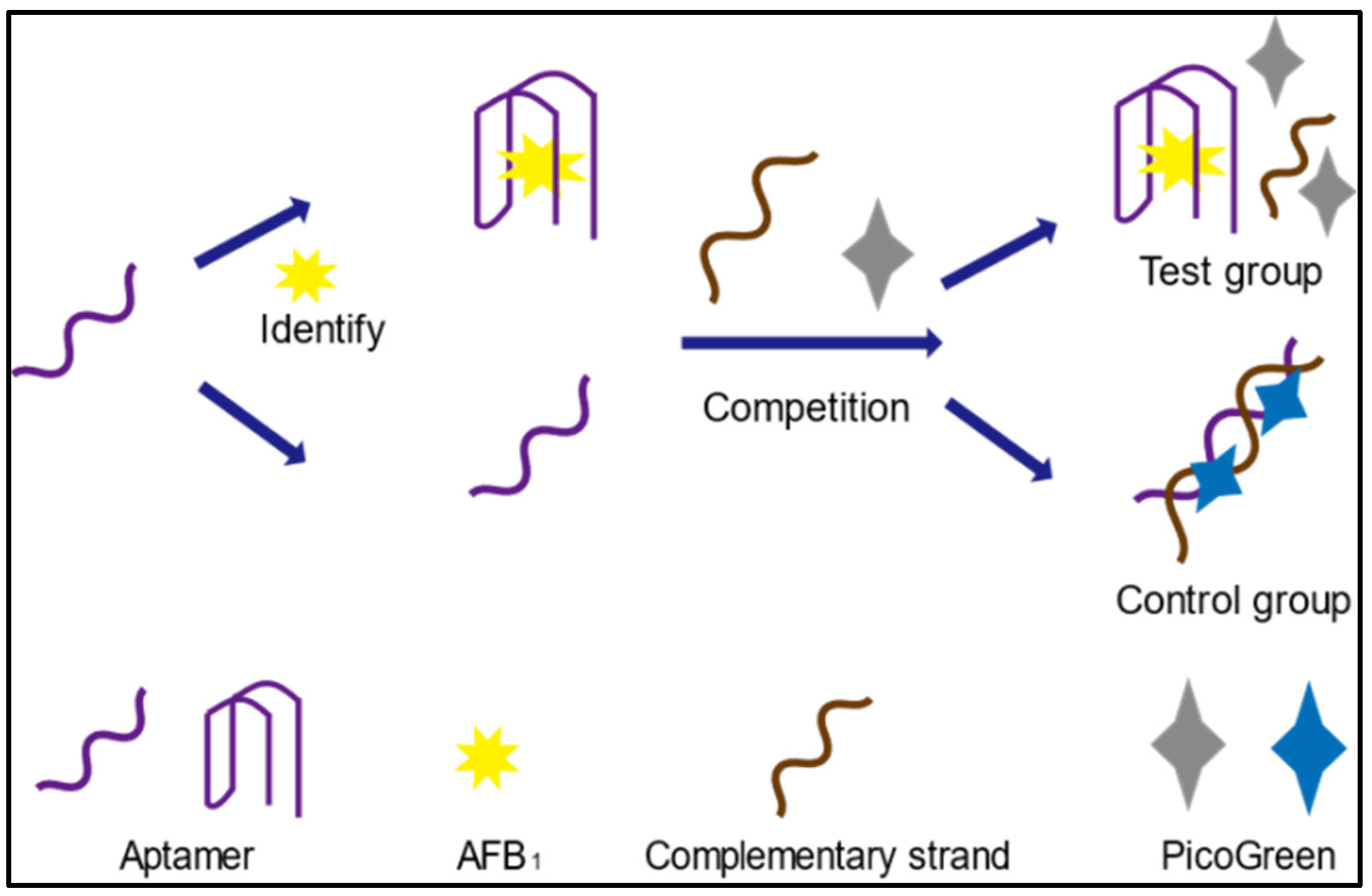
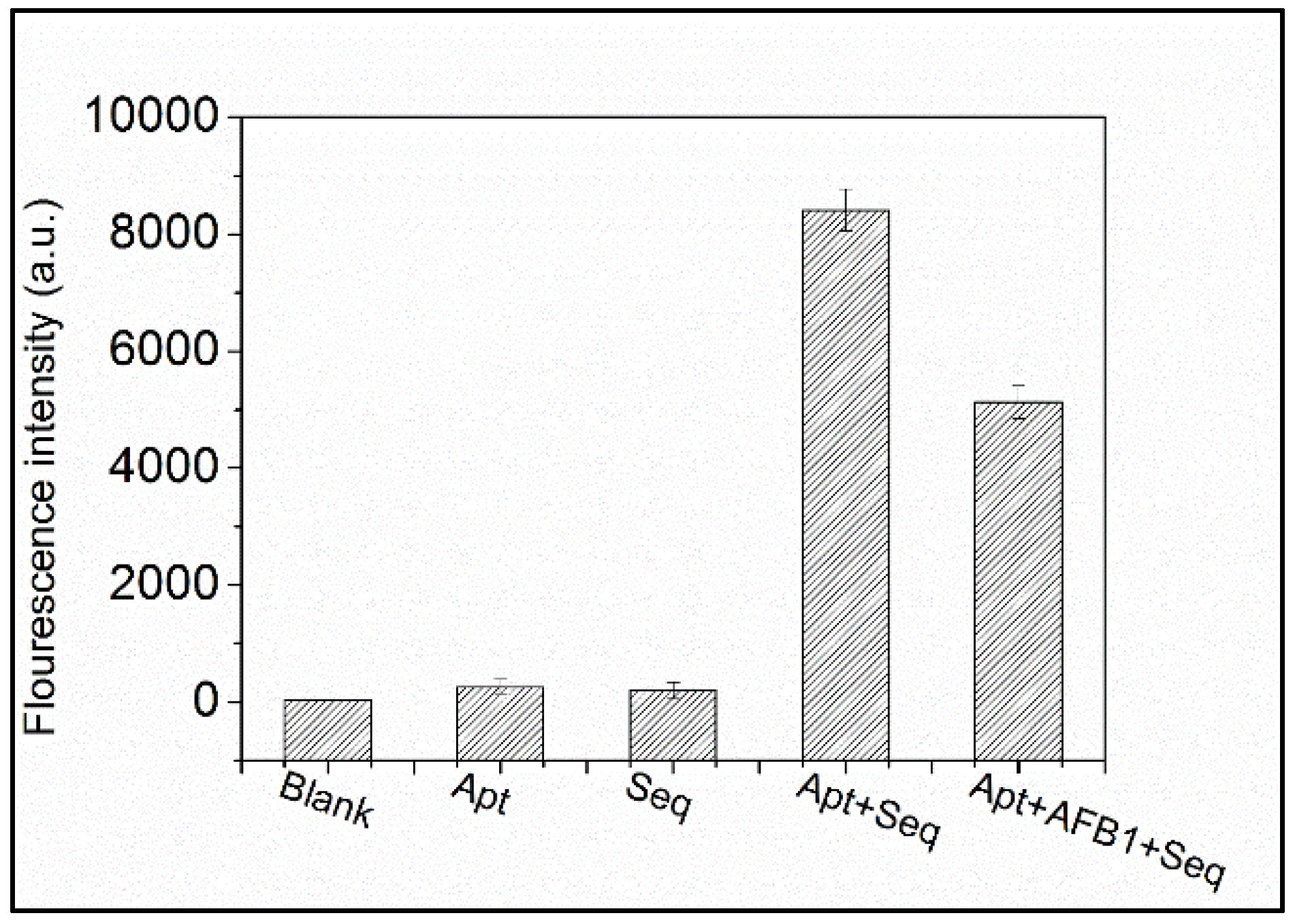
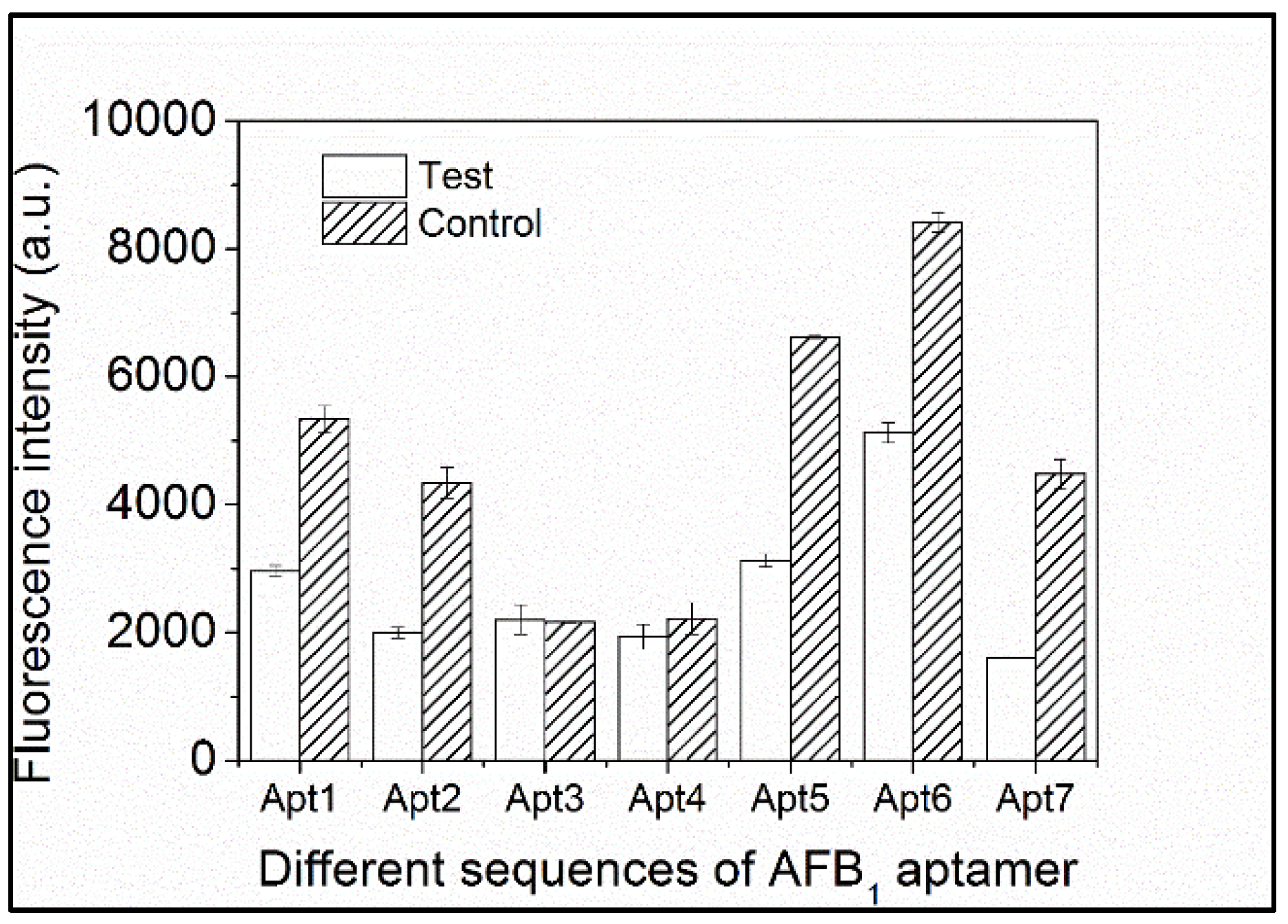
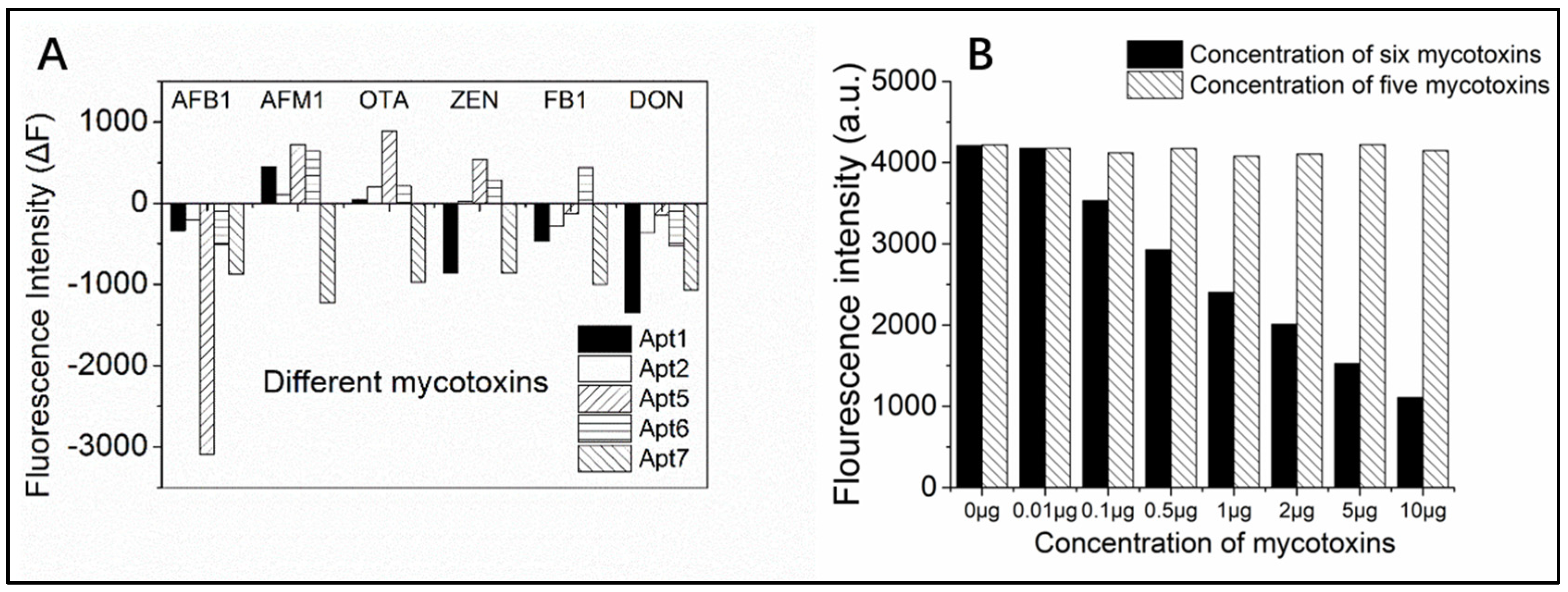
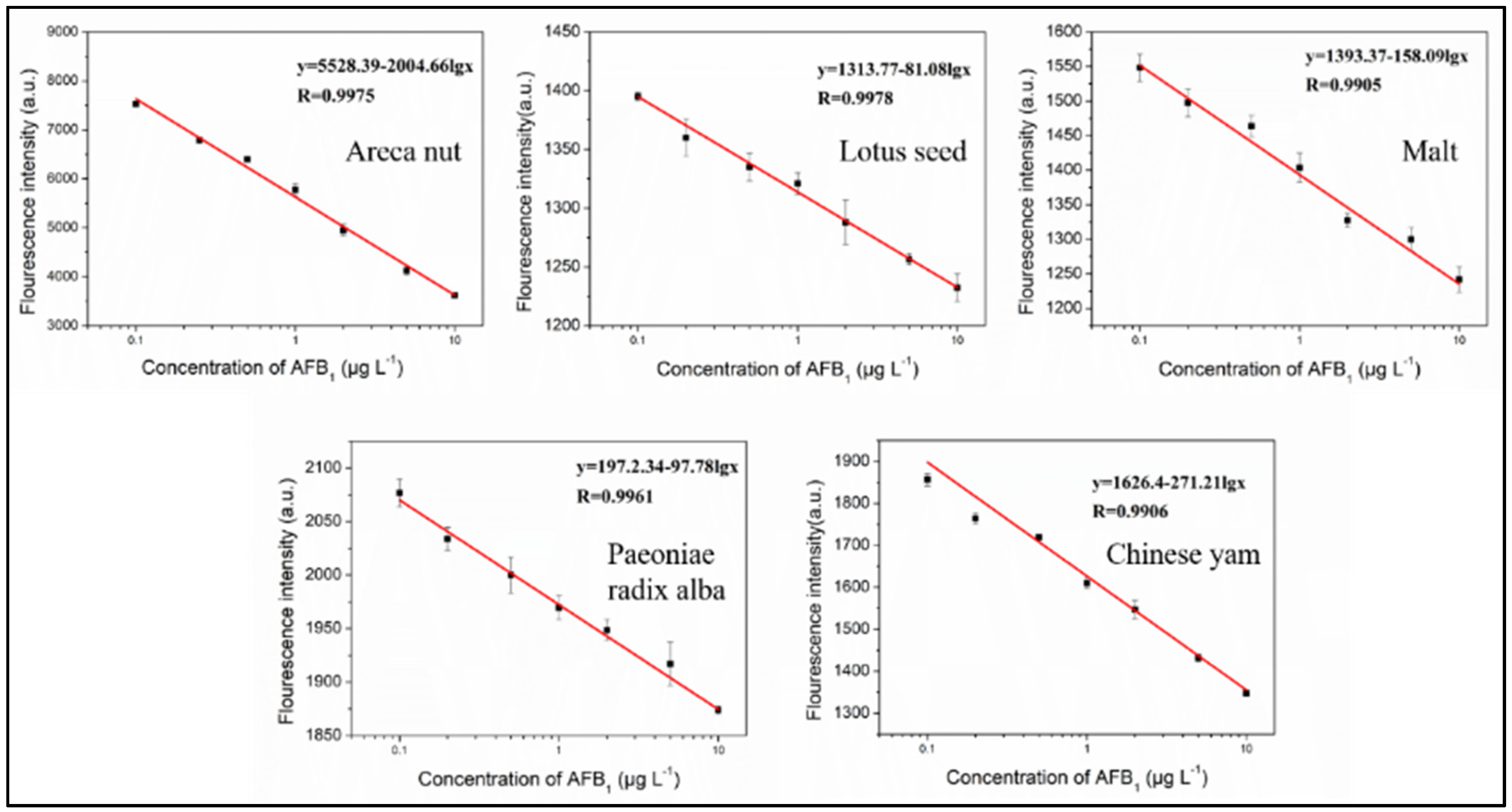
| NO. | Sequence (5′–3′) | References |
|---|---|---|
| Apt 1 | AGCAGCACAGAGGTCAGATGGTGCTATCATGCGCTCAATGGGAGACTTTAGCTGCCCCCACCTATGCGTGCTACCGTGAA | [30] |
| Apt 2 | AGCAGCACAGAGGTCAGATGTCTAAATGACACCTTTTCAACCTACTGACTTGGTTTACTACCTATGCGTGCTACCGTGAA | [30] |
| Apt 3 | GTTGGGCACGTGTTGTCTCTCTGTGTCTCGTGCCCTTCGCTAGGCCCACA | [31] |
| Apt 4 | AAAGTTGGGCACGTGTTGTCTCTCTGTGTCTCGTGCCCTTCGCTAGGCCCACAAAAA | [32] |
| Apt 5 | CAGCTTATTCAATTGTGCAGGGGGAGGGGGAGTGGTGGCTCGCGGTGCGTGGTGGCTGTAGATAGTAAGTGCAATCTA | [33] |
| Apt 6 | GCATCACTACAGTCATTACGCATCGGGTAATCCTAAGCGGAACTGAGGAGTGGGAGGTAAATCGTGTGAAGTGCTGTCCC | [34] |
| Apt 7 | TTTTTTGTTGGGCACGTGTTGTCTCTCTGTGTCTCGTGCCCTTCGCTAGGCCCAC | [35] |
| Recovery (%) | Spiking Level (μg·kg−1) (n = 3) | ||
|---|---|---|---|
| 2.5 | 5 | 10 | |
| Areca nut | 71.1 (2.6%) | 78.9 (9.1%) | 79.9 (10.2%) |
| Lotus seed | 82.4 (4.6%) | 81.4 (10.2%) | 95.4 (8.7%) |
| Malt | 75.5 (5.9%) | 78.5 (1.3%) | 100.4 (8.4%) |
| Paeoniae alba radix | 99.2 (7.2%) | 100.9 (4.6%) | 79.4 (6.4%) |
| Chinese yam | 89.4 (3.4%) | 88.7 (5.6%) | 95.5 (9.0%) |
| Samples | Aflatoxin B1 Contaminated Level (μg·kg−1) | RSD (%) | |
|---|---|---|---|
| Areca nut | China (Guangxi province) | ND | - |
| China (Hainan province) | <LOQ | - | |
| India | 1.1 | 4.6 | |
| Indonesia | 58.1 | 7.2 | |
| Philippines | 97.1 | 6.4 | |
| Lotus seed | China (Hunan province) | 63.2 | 5.7 |
| China (Hubei province) | ND | - | |
| China (Beijing province) | ND | - | |
| China (Fujian province) | ND | - | |
| Malt | China (Hebei province) | ND | - |
| China (Hebei province) | 0.8 | 4.9 | |
| China (Hebei province) | ND | - | |
| China (Hebei province) | ND | - | |
| Paeoniae alba radix | China (Zhejiang province) | ND | - |
| China (Anhui province) | ND | - | |
| China (Anhui province) | ND | - | |
| China (Anhui province) | ND | - | |
| Chinese yam | China (Henan province) | ND | - |
| China (Henan province) | ND | - | |
| China (Henan province) | ND | - | |
| China (Guangxi province) | ND | - | |
© 2018 by the authors. Licensee MDPI, Basel, Switzerland. This article is an open access article distributed under the terms and conditions of the Creative Commons Attribution (CC BY) license (http://creativecommons.org/licenses/by/4.0/).
Share and Cite
Zhang, C.; Dou, X.; Zhang, L.; Sun, M.; Zhao, M.; OuYang, Z.; Kong, D.; Antonio, F.L.; Yang, M. A Rapid Label-Free Fluorescent Aptasensor PicoGreen-Based Strategy for Aflatoxin B1 Detection in Traditional Chinese Medicines. Toxins 2018, 10, 101. https://doi.org/10.3390/toxins10030101
Zhang C, Dou X, Zhang L, Sun M, Zhao M, OuYang Z, Kong D, Antonio FL, Yang M. A Rapid Label-Free Fluorescent Aptasensor PicoGreen-Based Strategy for Aflatoxin B1 Detection in Traditional Chinese Medicines. Toxins. 2018; 10(3):101. https://doi.org/10.3390/toxins10030101
Chicago/Turabian StyleZhang, Cheng, Xiaowen Dou, Lei Zhang, Meifeng Sun, Ming Zhao, Zhen OuYang, Dandan Kong, F. Logrieco Antonio, and Meihua Yang. 2018. "A Rapid Label-Free Fluorescent Aptasensor PicoGreen-Based Strategy for Aflatoxin B1 Detection in Traditional Chinese Medicines" Toxins 10, no. 3: 101. https://doi.org/10.3390/toxins10030101





